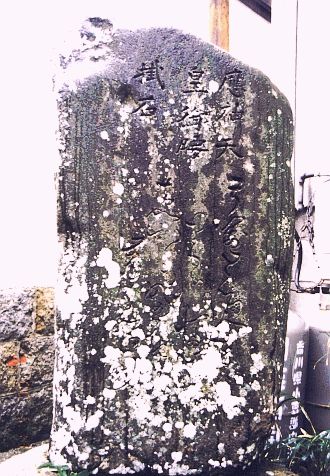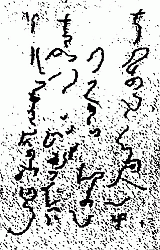
One
of the Earliest Japanese
Letters
found at Shikoku, on a Memorial Stele dated 291 A.D
Nobuhiro Yoshida
Chairman of the Japan Petrograph Society
jps@qd5.so-net.ne.jp
At an ancient memorial site of Ohjin
Tenno, in Shodojima Island,
Kagawa Prefecture,
dated 291 A.D.,
letters engraved on a stele were
found by Hiroaki
Hayashi on March 19th
2000.

The stele at the memorial
site of Ohjin Tenno (Photo:
N. Yoshida)
The Kanjis at the top of the stele have been engraved around
1000 A.D. It reads
from right up to left :
"Ohjin Tenno (emperor) On (valuable)
Koshi-kake (rested
upon) Ishi (rock)."
It was rainy, and the wet surface of the stele helped him
notice the letters.

The pre-kanji inscriptions discovered on the lower part of
the stele
In one of the oldest Japanese
history books,
Nihon-shoki, it is writen that
Ohjin Tenno came to the island of
Shodojima. He is said to have
rested on the stone
for a while with his bow leaning
against a rock nearby. It was in
September 291 A.D.,
and is memorialised by local historians, carved in the stone
as now seen.
Although it is difficult for us to know which letter-code
one should use
in order to decode the inscriptions, one can be sure that
even before the
introduction of ‘Kanji’ (Chinese
characters) into Japan,
there were local alphabets or syllabaries to record and
carry messages.
Most Japanese archaeologists, linguists and language
professors used to deny this
fact,
insisting that there had been no specific letters nor
alphabets in earliest Japan.
To our surprise, they refuse to admit the real existence of
inscriptions,
petroglyphs, or engravings
even given the global occurence in human culture of letters
and
rock art.
This might result of their fear that if they admit such an ancien human
literary
and spiritual heritage,
they will lose their authority or pride which had been gained
through an antiquated presumption
or belief that there were no
signs, no letters, no alphabets but only oral tradition
in those days before 'Kanji' were
officially introduced into Japan
by the Kinki dynasty, in the 650’s A D.
Why such presumption ?
How could they be so stubborn in these days when so much
rock
art and petroglyphs have been found worldwide ?
If you have been interested by this text, you may like hanzihemeng 01/24/04 11:51